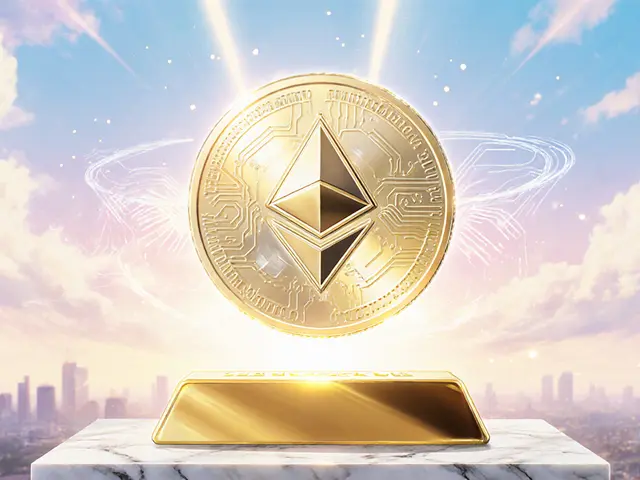Ethereum Gas Fee Calculator
Estimate Your Transaction Costs
See how much you save by using Layer 2 networks compared to Ethereum Mainnet
How This Works
Layer 2 solutions process transactions off-chain and only submit compressed data to Ethereum Mainnet. This reduces gas fees significantly while maintaining security.
| Network | Cost per Transaction | Reduction |
|---|---|---|
| Ethereum Mainnet | $0.41 | 1× (baseline) |
| Arbitrum | $0.01 | ≈98% cheaper |
| Optimism | $0.008 | ≈98% cheaper |
| Base | $0.009 | ≈98% cheaper |
When people talk about the Layer 2 solutions are protocols that handle transactions off the Ethereum main chain while still anchoring data back to it for security, the first thing that comes to mind is cheaper, faster trades. In 2025 the average fee on Ethereum fell to $0.41 - a level not seen in four years - thanks largely to these rollups. This article breaks down why that dip matters, which networks lead the charge, and how developers and everyday users can stay ahead of the next fee wave.
Key Takeaways
- Ethereum’s average gas price is now under $0.50, but spikes still happen during market‑wide events.
- Arbitrum, Optimism and Base charge roughly 99% less per transaction than the mainnet.
- AI‑powered routing tools can shave an extra 10‑20% off fees by picking the cheapest moment and path.
- Bridging to a Layer 2 incurs a one‑time mainnet cost, then most actions become pennies.
- Future fee drops will rely on better rollup designs, cross‑chain bridges, and validator economics.
Recent Gas Fee Trends (2023‑2025)
Two years ago, a simple token swap could cost $70 during NFT hype. By early 2024 the average settled around $5, and in February 2025 the network posted a 38% day‑to‑day drop, hitting 3.146 Gwei - a 94% improvement over the same date a year earlier. Daily total fees shrank from $23 million at peak to $7.5 million, showing a 70% reduction in overall network cost.
These numbers aren’t just nice headlines; they translate into real‑world savings for DeFi users, gamers, and anyone sending crypto to friends. However, the data also reveals a pattern: whenever a major token launch or a market rally spikes demand, fees can temporarily jump back above $50 per swap. Knowing when these windows close is the new skill set for crypto traders.
Why Layer 2 Cuts Fees
Layer 2 protocols bundle many transactions into a single batch, compute the results off‑chain, and then post a compact proof to Ethereum. This “rollup” model moves the heavy lifting away from the execution layer, so the mainnet only needs to verify a succinct calldata blob. Fewer computations mean lower gas consumption per user.
Two main rollup families dominate today:
- Optimistic Rollups assume transactions are valid and only challenge them if a fraud proof is submitted.
- ZK Rollups generate zero‑knowledge proofs that guarantee correctness before posting to Ethereum.
Both approaches achieve the same economic goal: spread the cost of a single L1 commit across dozens or hundreds of L2 transactions, making each user’s fee a fraction of the original.

Major Players and Their Price Points
| Network | Typical fee per tx | Fee reduction vs Ethereum L1 |
|---|---|---|
| Ethereum Mainnet | $0.41 | 1× (baseline) |
| Arbitrum | $0.01 | ≈98% cheaper |
| Optimism | $0.008 | ≈98% cheaper |
| Base | $0.009 | ≈98% cheaper |
All three rollups use optimistic or ZK technology and settle with Ethereum roughly every 5‑15 minutes. The slight fee differences come from validator incentives and network congestion on the respective L2.
AI‑Powered Gas Optimization Tools
2025 also saw the rise of smart routing services that query multiple L2s, estimate current gas, and predict near‑future price swings using machine‑learning models. Tools like GasGuru and FeeWizard let users set a maximum acceptable fee; the platform then automatically submits the transaction at the optimal moment or via the cheapest rollup.
Real‑world tests show a 12% average saving compared with manual timing, and up to 25% for high‑frequency traders who keep a cross‑chain bridge open to shift assets between networks on the fly.

Future Outlook: What’s Next for Fees?
Several trends point to continued downward pressure:
- More sophisticated rollups: Next‑gen ZK proofs promise sub‑millisecond verification, cutting L1 calldata even further.
- Validator economics: With Ethereum’s shift to Proof‑of‑Stake, fees now reward validators rather than miners, smoothing price volatility over time.
- Cross‑chain competition: BNB Chain’s proposal to halve its own gas fees adds market pressure, potentially inspiring Ethereum‑side fee rebates.
- Regulatory clarity: U.S. legislation supporting stablecoin use is pushing institutional money onto Ethereum, increasing volume but also encouraging efficiency improvements.
Analysts from TokenMetrics predict that by 2027 the average fee for a simple transfer on a well‑optimized L2 could dip below $0.001, effectively making micro‑payments viable for gaming and IoT.
Practical Tips for Users and Developers
- Start with a small bridge transfer to your preferred L2; the one‑time Ethereum cost is worth the long‑term savings.
- Monitor Etherscan’s Gas Tracker (or similar tools) for off‑peak windows-usually weekends or post‑market hours.
- Enable “auto‑adjust gas” in wallets that support it; they will pick the cheapest L2 route in real time.
- For DeFi contracts, batch operations when possible. Many protocols now let you submit a single batch transaction that executes multiple swaps internally.
- Keep a modest ETH reserve for occasional L1 interactions (e.g., withdrawing from an L2 or voting on a DAO).
Frequently Asked Questions
Do I need to pay gas fees on both L1 and L2?
Yes. The initial bridge transaction uses Ethereum mainnet gas, but once your assets are on the L2, subsequent actions cost only the tiny L2 fee.
Which Layer 2 is best for a beginner?
Arbitrum and Optimism both have wallet integrations that mirror the familiar Ethereum UI, making them the easiest entry points.
Can I switch between Layer 2s without paying another bridge fee?
Not directly. You need to bridge back to L1 first, then to the new L2, incurring two small mainnet fees. Some emerging cross‑rollup bridges aim to combine these steps in 2026.
How do AI routing tools decide the cheapest path?
They scrape live gas data from multiple L2s, apply predictive models trained on historical congestion patterns, and execute the transaction when the projected fee drops below your set threshold.
Will gas fees ever reach zero?
Zero fees are unlikely because validators need some reward to secure the network. However, fees are expected to become negligible for most everyday use cases.



Marina Campenni
May 19, 2025 AT 23:21Seeing gas fees dip below half a dollar is a relief for anyone who’s been paying tens of dollars for a simple swap; the migration to rollups really shows its teeth.
Irish Mae Lariosa
May 22, 2025 AT 01:21While the headline numbers look enticing, the underlying reality is that most users are still forced to endure occasional price spikes that can erase weeks of savings; the article glosses over how fickle market sentiment can inflate L2 congestion in seconds; it also fails to mention that optimistic rollups, despite their promise, still rely on fraud proofs that can delay finality during attacks; moreover, the cited 99% reduction applies only when the network is idle, which is rarely the case during token launches; the analysis omits the fact that bridging back to L1 incurs a non‑trivial cost that many newcomers overlook; similarly, the piece assumes that AI routing tools are universally accessible, ignoring that they require premium subscriptions; there is also a lack of discussion about how validator incentives on L2s could shift, potentially raising fees in the future; the comparison table, while useful, does not account for network upgrades that could change the fee landscape; furthermore, the article does not address user experience friction when switching between rollups, which can be a barrier for mainstream adoption; the claim that fees will approach zero by 2027 seems overly optimistic given the inevitable economic trade‑offs; another omission is the environmental impact of maintaining multiple rollup ecosystems; additionally, the piece understates the risk of centralized bridge operators becoming points of failure; the narrative also sidesteps regulatory uncertainty that could force expensive compliance layers on L2s; finally, the optimism about cross‑chain competition ignores that some chains may prioritize their own native tokens, thereby re‑introducing hidden costs; overall, the article paints a rosy picture while leaving out many of the systemic challenges that could temper the fee reduction trend.
Nick O'Connor
May 24, 2025 AT 03:21Indeed, the shift to Layer 2, with its myriad of rollup designs, batch processing, and proof systems, represents a paradigm shift, but users should remain vigilant, especially when monitoring gas trackers, bridging costs, and the occasional network hiccup.
Ikenna Okonkwo
May 26, 2025 AT 05:21From a broader perspective, the emergence of affordable rollups can be seen as an evolution toward a more inclusive digital economy; as friction decreases, creativity flourishes, and communities find new ways to collaborate across borders.
Katharine Sipio
May 28, 2025 AT 07:21Start small, bridge once, and enjoy the savings.
David Moss
May 30, 2025 AT 09:21People need to realize that the “low fees” narrative is being pushed by a hidden elite that wants us to believe everything is free while they quietly hoard the real value; the truth is buried beneath layers of code, and only the vigilant will see it.
Jessica Cadis
June 1, 2025 AT 11:21When you look at how different regions adopt rollups, it’s clear that cultural attitudes towards risk shape which L2 gains traction, and that’s why we see distinct ecosystems forming across continents.
Shikhar Shukla
June 3, 2025 AT 13:21It is imperative, from a scholarly standpoint, to critically assess the assumptions behind fee projections; otherwise, one risks propagating an incomplete understanding of blockchain economics.
lida norman
June 5, 2025 AT 15:21That was a brutal dissection, but I feel the pain of every trader who’s seen a sudden spike; the reality hits hard, and we’re all just trying to survive this roller‑coaster 🌪️.
Devi Jaga
June 7, 2025 AT 17:21Sure, because adding a tornado emoji magically solves the scalability conundrum; let’s just sprinkle some buzzwords and hope the protocol magically optimizes itself.
Kaitlyn Zimmerman
June 9, 2025 AT 19:21For anyone looking to minimize costs, keep an eye on the gas tracker during off‑peak hours, enable auto‑adjust features in your wallet, and consider batching transactions whenever possible.
DeAnna Brown
June 11, 2025 AT 21:21Honestly, if you follow those simple steps you’ll never pay more than a few cents, and that’s why the United States should champion these technologies as the future of finance.
Chris Morano
June 13, 2025 AT 23:21Even with occasional spikes, the overall trend toward cheaper transactions is encouraging for developers and users alike.
Carolyn Pritchett
June 16, 2025 AT 01:21Let’s not kid ourselves-this “trend” is just a gimmick to distract from the real centralization problem brewing under the surface.
Cecilia Cecilia
June 18, 2025 AT 03:21The data supports cautious optimism, though vigilance remains essential.